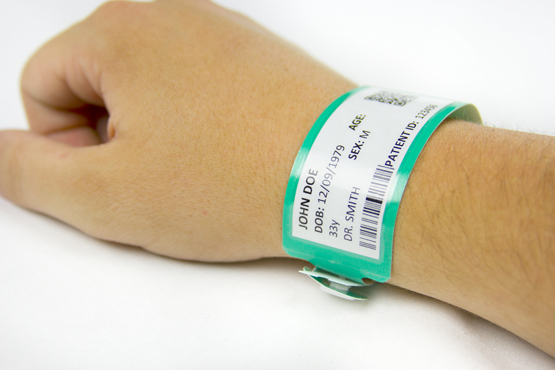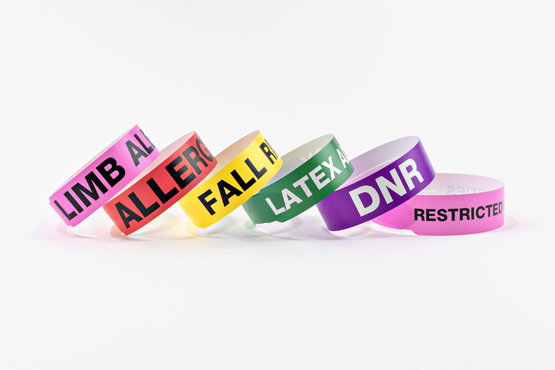The Increasing Need for Advanced Patient Identification Bands in Modern Healthcare Facilities
The Increasing Need for Advanced Patient Identification Bands in Modern Healthcare Facilities
Blog Article
Exploring the Different Sorts Of Patient Identification Band Made Use Of in Clinical Facilities
In the intricate globe of medical care, the vital duty of Patient Identification bands often goes unnoticed. These bands, differing from straightforward paper wristbands to sophisticated RFID bands, create the backbone of Patient safety and security protocols, making sure precision in Patient Identification.
Recognizing the Importance of Patient Identification Bands
While they may seem like plain accessories, Patient Identification bands play a crucial function in medical facilities. These bands offer as an important tool for confirming Patient identity, protecting against medical mistakes connected to misidentification. Patient Identification bands also help in improving management tasks, guaranteeing precise record-keeping and billing.
Conventional Paper Wristbands: Their Use and Limitations
Conventional paper wristbands have actually been a staple in Patient Identification across different medical centers. While their usage is extensive, they nurture particular restrictions that may impact their performance in Patient administration. This section will certainly concentrate on the range of their application and the integral downsides connected with their use.
Paper Wristbands: Use Scope
In the realm of Patient Identification, paper wristbands have actually long held an essential function. These bands are usually used in outpatient setups, where the Patient's remain is short-lived. In spite of innovations in modern technology, the humble paper wristband stays a trustworthy and cost-efficient remedy for Patient Identification in different healthcare circumstances.
Limitations of Paper Wristbands
In spite of their extensive usage, paper wristbands are not without their disadvantages. In enhancement, paper wristbands often do not have the technical abilities of more contemporary choices, such as barcoding or RFID chips, restricting their functionality to simply showing written information. Paper wristbands can trigger pain or skin inflammation to some individuals, specifically when used for extensive periods.
Barcoded Wristbands: Improvements in Patient Identification
While Patient Identification has actually long been a crucial aspect of health care, the development of barcoded wristbands symbolizes a substantial jump onward. These bands leverage the simpleness of barcoding technology, allowing for Patient information to be swiftly checked and accessed. They improve the rate and precision of Patient Identification, reducing the threat of clinical mistakes related to misidentification.
Radio Regularity Identification (RFID) Bands: an Action Towards Futuristic Healthcare
The evolution of Patient Identification bands has produced the emergence of Superhigh frequency Identification (RFID) Bands (patient identification band). These ingenious devices present vital benefits for healthcare facilities, using a much more reliable and technically advanced ways of Patient Identification. The application of RFID in health care is a substantial action in the direction of a more advanced strategy to Patient monitoring and safety
Recognizing RFID Bands

RFID Bands: Trick Benefits
Largely, these bands improve Patient safety and security by offering exact, immediate Identification, therefore minimizing clinical mistakes. RFID bands can save a huge quantity of Patient data, consisting of clinical background and allergies, allowing personalized treatment. Generally, RFID bands stand for a considerable improvement in Patient Identification innovation, benefiting both patients and medical care companies.
Applying RFID in Health Care
As we enter a technically advanced period, the execution of RFID bands in health care becomes significantly essential. These bands give a seamless means to track and recognize patients, ensuring their safety and boosting effectiveness in therapy procedures. RFID bands provide countless benefits over typical Identification methods. They can store a huge amount pop over to this web-site of information, consisting of the Patient's clinical background and treatment plans, which can be quickly accessed by health care suppliers. This data helps physicians make informed decisions concerning the Patient's treatment strategy. RFID bands lower clinical mistakes by offering accurate Patient Identification, which is critical in stopping misdiagnosis or wrong medication administration. Hence, the implementation of RFID bands is a significant step in the direction of boosting Patient safety and security and medical care distribution.

Color-Coded Wristbands: Aiding in Quick and Accurate Medical Diagnosis
In the bustling atmosphere of a clinical facility, color-coded wristbands have become vital devices for swift and accurate Identification of a person's clinical condition. These wristbands, worn by patients, lug particular colors that match to various medical conditions or conditions. Red might show allergy threats, while yellow may indicate a fall risk. This system is developed to offer immediate visual signs to doctor, boosting Patient safety and care quality. In emergency situation circumstances, using these wristbands allows for quick decision-making. The effectiveness of color-coded wristbands depends on the harmony of shade analysis throughout health care institutions, requiring common standards for regular application.
Approaches for Reliable Implementation and Administration of Patient ID Bands
Accomplishing ideal see it here usage of Patient Identification bands demands a well-structured strategy for their execution and monitoring. The very first step includes training all health personnel on the relevance of appropriately applying and reviewing these bands. Second of all, hospitals must standardize the use of ID bands throughout all departments, making certain uniformity and lowering inconsistencies. Normal audits ought to be conducted to verify adherence to policies and to rectify any kind of incongruities. Patient education and learning is additionally essential; individuals need to recognize the objective of the bands and the demand for their constant wear. patient identification band. It's important to have a back-up plan in location, such as barcode scanning or navigate to this site biometrics, to ensure that Patient Identification is never ever jeopardized.
Verdict
Patient Identification bands are vital in medical centers to ensure safety and security and accuracy. Efficient application and monitoring of these bands can substantially reduce clinical mistakes, increase efficiency, and improve total Patient treatment.
These bands, differing from basic paper wristbands to advanced RFID bands, form the backbone of Patient safety and security methods, making certain precision in Patient Identification.The evolution of Patient Identification bands has actually brought about the emergence of Radio Regularity Identification (RFID) Bands. In general, RFID bands represent a substantial innovation in Patient Identification modern technology, profiting both patients and health care companies.
RFID bands minimize medical errors by providing accurate Patient Identification, which is essential in protecting against misdiagnosis or wrong medication administration. Patient education is also critical; people should recognize the purpose of the bands and the need for their constant wear.
Report this page